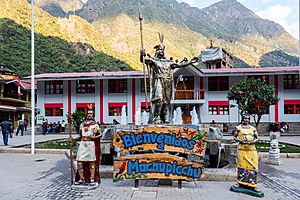Aguas Calientes, Peru facts for kids
Quick facts for kids
Machupicchu
Machu Pikchu
Machupicchu Pueblo
|
|
|---|---|
|
Town
|
|

Statue of Pachacutec
|
|
| Country | |
| Region | Cusco |
| Province | Urubamba |
| District | Machupicchu |
| Settled | 1901 |
| District Capital | 1 October 1941 |
| Elevation | 2,040 m (6,690 ft) |
| Population
(2017)
|
|
| • Total | 4,525 |
| Time zone | UTC-5 (PET) |
Machupicchu or Machupicchu Pueblo is a town in Peru. It is also known as Aguas Calientes, which means "hot waters" in Spanish. This town is located in the Cusco Region, within the Urubamba Province. It sits right next to the Urubamba River.
Machupicchu Pueblo is very important because it is the closest town to the famous ancient site of Machu Picchu. The ruins are about 6 kilometers (4 miles) away, which is about a 90-minute walk. Many tourists stay here because there are lots of hotels and restaurants. The town also has natural hot baths, which is how it got its name, Aguas Calientes.
The village of Machupicchu did not exist until the railroad was built. It started as a camp for construction workers. After the railroad opened in 1931, more and more tourists came to visit the Machu Picchu ruins. People then started businesses like restaurants and small hotels to serve these visitors.
Contents
What's in a Name?
The official name, Machu Pikchu, comes from the Quechua language. In Quechua, machu means "old" or "old person." Pikchu can mean "pyramid," "mountain," or a "prominence with a broad base that ends in sharp peaks." The word "pueblo" was added from Spanish, meaning "town."
Before it was officially called Machupicchu Pueblo, it was known as Aguas Calientes. This name means "hot waters" or "hot springs" because of the natural warm baths found there.
A Brief History
Machupicchu Pueblo began as a small settlement with a few farm families in 1901. In the late 1920s, it changed into a busy camp for railway workers. This camp was called Maquinachayoq. This name means "(place) with a little train" in Quechua.
The town was the main place for workers to stay and keep their equipment. This was during the construction of the railroad. The railway was finished in 1931, and the town grew from there.
Getting Around Machupicchu
Machupicchu Pueblo is the end point for passenger trains from Cusco. These trains, run by PeruRail and Inca Rail, bring both local people and tourists. Visitors come from Cusco and Ollantaytambo to see Machu Picchu.
The main street in town is called Avenue Pachacutec. It is the only major road and connects the hot baths to the town's main square.
Powering the Region
Near Machupicchu, along the Urubamba River, is the Central Machupicchu Hydroelectric Plant. This plant uses the power of water to create electricity. It generates about 90 megawatts of power. This electricity helps supply the regions of Cusco, Puno, and Apurímac.
The plant was first built between 1958 and 1965. It was made bigger between 1981 and 1985. In 1998, a landslide damaged the plant. It stopped working until 2001 when it was repaired.
Images for kids
-
The Urubamba River flowing through Machupicchu Pueblo.
Sister Cities
Machupicchu Pueblo has "twin towns" or "sister cities" around the world. These are places that have friendly connections and share cultural ties.
 Haworth, United Kingdom
Haworth, United Kingdom Otama village, Fukushima Prefecture, Japan
Otama village, Fukushima Prefecture, Japan Fukushima, Japan
Fukushima, Japan Petra, Jordan
Petra, Jordan Medley, United States
Medley, United States Tinum, Mexico
Tinum, Mexico
See also
 In Spanish: Aguas Calientes (Perú) para niños
In Spanish: Aguas Calientes (Perú) para niños










